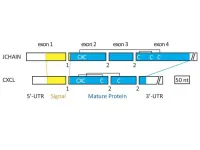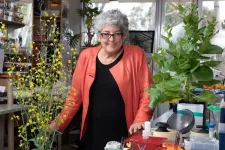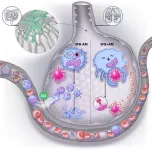(Press-News.org) A new study led by researchers at UCLA may change the way clinicians and scientists understand, diagnose and treat placenta accreta spectrum disorder, a serious condition in which the placenta fails to separate from the uterus at birth, jeopardizing the life and health of both mother and baby.
Researchers previously believed that certain overly invasive placental cells, called trophoblasts, were responsible for keeping the connection intact. But this new research, which identifies genetic and cellular changes within single cells where the placenta and uterus join, shifts the focus to how the structural support of tissues, and the blood vessels of the uterus, can cause a “loss of normal boundary limits” between the placenta and the uterus.
“We utilized two new techniques in single-cell analysis to create an atlas of cells involved in placenta accreta to better understand this increasingly prevalent disorder that can have devastating implications for maternal and neonatal health,” said Dr. Yalda Afshar, a maternal-fetal medicine specialist and researcher at the David Geffen School of Medicine at UCLA, and the first and corresponding author of an article describing the findings in the American Journal of Obstetrics & Gynecology.
“This work revealed a subset of genes differentially expressed in placenta accreta spectrum disorder, which provides the basis for the ‘permissive environment’ for the placenta to attach to the uterine lining,” said Dr. Deborah Krakow, a maternal-fetal medicine specialist and researcher, chair of the Department of Obstetrics and Gynecology at the David Geffen School of Medicine at UCLA, and the paper’s senior author.
The research showed that the decidua, the layer of the uterine lining that forms during pregnancy, and blood vessels, are sending different signals to the placenta when a pregnant person has placenta accreta. Normally, the placenta – the temporary organ that provides support for a fetus – is shed after birth. In placenta accreta, it is stuck on too tight, which becomes the reason for many of the maternal complications of placenta accreta.
“Our goal was to characterize the intimate relationship between the maternal and fetal tissue at the site of accreta or malfunction,” Afshar said. “The genes and signaling pathways we identified go beyond providing a better understanding of the mechanism of the disease; they may be used as targets to help us refine diagnostic tests, track disease progression over time, and discover new, more effective therapies.”
The incidence of placenta accreta spectrum (PAS) disorders has increased dramatically in recent decades, the cause of which is not certain, though cesarean deliveries, is one of several risk factors. Today, incidence is estimated at 1 in 272 births in the U.S., up from 1 in about 30,000 pregnancies in the 1960s, researchers say.
For this study, the research team performed multiple placental biopsies on 12 placentas – six with PAS disorder and six controls – conducting single-cell RNA analysis on 31,406 individual cells. The researchers also applied spatial transcriptomics to 36 regions of interest – 12 in PAS-adherent, 12 in PAS-nonadherent, and 12 in controls. Spatial transcriptomics allow researchers to precisely measure and map the gene activity within a single tissue sample.
“At the end of the day, understanding the biology of pregnancy and pregnancy-related diseases, like accreta, is inspired by only one thing – finding ways to improve the care we can provide to pregnant people and their families,” said Afshar, a physician-scientist who manages the care of many patients with placenta accreta spectrum disorders at UCLA Health.
Authors In addition to Dr. Krakow and Dr. Afshar, UCLA co-authors include Ophelia Yin, MD; Anhyo Jeong; Guadalupe Martinez; Feiyang Ma, PhD; Christine Jang, PharmD; Sarah Tabatabaei; Hsian-Rong Tseng, PhD; and Yazhen Zhu, MD, PhD. Dr. Yin is also with the University of California, San Francisco. From Cedars-Sinai Medical Center: Jina Kim, PhD; and Sungyong You, PhD.
END
Study provides new explanation for why placenta may not properly separate at birth, putting mother and newborn at risk
UCLA researchers identify genetic and cellular changes underlying placenta accreta spectrum disorder, affecting 4 million births in the U.S. annually
2024-01-30
ELSE PRESS RELEASES FROM THIS DATE:
Ethnic disparities in cancer mortality in the capital and northeast of the State of São Paulo, Brazil
2024-01-30
Although the interior of São Paulo state (Brazil) has higher human development indices (HDIs) and fewer Black people as a percentage of the population, they account for a larger proportion of deaths from cancer in the Barretos region than in São Paulo city, the state capital, according to a study supported by FAPESP. An article on the study is published in the journal Cancer Causes & Control.
In the 18 cities of the Barretos regional health district (RHD), the number ...
Evolutionary origin of mysterious immune system molecule in humans revealed
2024-01-30
UNIVERSITY PARK, Pa. — Biological systems can behave as siblings in several ways, including by borrowing something and never giving it back. That appears to be what the human immune system did with a protein that now helps bind and regulate the subunits that make up antibodies, according to a multi-institute research collaboration. They found that, before the immune system evolutionarily co-opted it, the protein originally belonged to gene family responsible for directing cells to move to the right location at the right time to address specific functional needs.
The researchers, including Kazuhiko Kawasaki, associate research professor of ...
UCSF scientist wins Barancik Prize for Innovation in MS Research
2024-01-30
[New York, January 30, 2024] – Sergio E. Baranzini, PhD, a geneticist, neuroimmunologist and data scientist at the University of California, San Francisco, is the winner of this year’s Barancik Prize for Innovation in MS Research. Dr. Baranzini is being recognized for his pioneering efforts to integrate vast pools of information to understand complex mechanisms that cause MS and to develop more precise approaches to stop the disease and end it by prevention.
Baranzini is a Distinguished Professor and holds the Heidrich Friends and Family endowed chair in Neurology at the University of California, San Francisco ...
Salk Professor Joanne Chory honored with Benjamin Franklin Medal in Life Science
2024-01-30
LA JOLLA (January 30, 2024)—Salk Institute Professor Joanne Chory has been selected by the Franklin Institute in Philadelphia to receive a Benjamin Franklin Medal in Life Science for her achievements in plant science. She will receive a 14-karat gold medal and a $10,000 honorarium at the Franklin Institute Awards Ceremony in April 2024. Chory joins other extraordinary scientists and engineers as a Franklin laureate, including Nikola Tesla, Marie and Pierre Curie, Thomas Edison, Albert Einstein, and Jane Goodall, among others.
“Joanne’s contributions to the field of plant biology have impacted and will continue to impact scientists around the world,” ...
Study finds gut microbiota influence severity of respiratory viral infection
2024-01-30
The composition of microbiota found in the gut influences how susceptible mice are to respiratory virus infections and the severity of these infections, according to researchers from the Center for Translational Antiviral Research in the Institute for Biomedical Sciences at Georgia State University.
The findings, published in the journal Cell Host & Microbe, report that segmented filamentous bacteria, a bacterial species found in the intestines, protected mice ...
Smartphone-based shopping mall walking program and daily walking steps
2024-01-30
About The Study: This study found that the use of a smartphone-based mall walking program combined with physical shopping mall facilities and lottery-based digital incentive coupons may motivate people to increase their daily number of walking steps.
Authors: Masamichi Hanazato, Ph.D., of Chiba University in Chiba-shi, Chiba, Japan, is the corresponding author.
To access the embargoed study: Visit our For The Media website at this link https://media.jamanetwork.com/
(doi: 10.1001/jamanetworkopen.2023.53957)
Editor’s ...
Comparison of sleeve gastrectomy vs Roux-en-Y gastric bypass
2024-01-30
About The Study: This randomized clinical trial of 1,735 patients undergoing primary bariatric surgery found that both laparoscopic sleeve gastrectomy and laparoscopic Roux-en-Y gastric bypass were performed with a low perioperative risk without clinically significant differences between groups.
Authors: Suzanne Hedberg, M.D., Ph.D., of the University of Gothenburg in Gothenburg, Sweden is the corresponding author.
To access the embargoed study: Visit our For The Media website at this link https://media.jamanetwork.com/
(doi: 10.1001/jamanetworkopen.2023.53141)
Editor’s Note: Please see the article for additional information, including ...
Worries about costs, time off work and COVID-19 kept some older adults from having surgery
2024-01-30
When it comes to having surgery, older adults don’t just base their decision on how much pain they’ll feel and how quickly they’ll recover, a new study finds.
Many also have serious concerns about how much they’ll have to pay out of their own pockets, how much work they’ll miss, and whether they’ll catch COVID-19 in the hospital or surgery center.
And a majority of those who called themselves very concerned about these issues ended up not having an operation that they had considered having, the study finds. The percentage who didn’t go through with surgery was much lower among those who said they’d been very concerned about pain or the ...
JMIR Perioperative Medicine invites submissions on perioperative blood management
2024-01-30
JMIR Publications is pleased to announce a new theme issue titled “Perioperative Blood Management” in JMIR Perioperative Medicine. The premier, peer-reviewed journal is indexed in PubMed and focuses on how technology and data science can improve care delivery and surgical patient outcomes. The new theme issue aims to explore the latest advancements, challenges, and patient-centered innovative approaches in optimizing blood-related practices before, during, and after surgical procedures.
JMIR Perioperative Medicine welcomes contributions from global researchers, clinicians, and experts in ...
Structural color ink: Printable, non-iridescent and lightweight
2024-01-30
A new way of creating color uses the scattering of light of specific wavelengths around tiny, almost perfectly round silicon crystals. This Kobe University development enables non-fading structural colors that do not depend on the viewing angle and can be printed. The material has a low environmental and biological impact and can be applied extremely thinly, promising significant weight improvements over conventional paints.
An object has color when light of a specific wavelength is reflected. With traditional pigments, this happens by molecules absorbing other colors from white light, but over time this interaction makes the molecules degrade and the color fades. ...
LAST 30 PRESS RELEASES:
Human adipose tissue: a new source for functional organoids
Metro lines double as freight highways during off-peak hours, Beijing study shows
Biomedical functions and applications of nanomaterials in tumor diagnosis and treatment: perspectives from ophthalmic oncology
3D imaging unveils how passivation improves perovskite solar cell performance
Enriching framework Al sites in 8-membered rings of Cu-SSZ-39 zeolite to enhance low-temperature ammonia selective catalytic reduction performance
AI-powered RNA drug development: a new frontier in therapeutics
Decoupling the HOR enhancement on PtRu: Dynamically matching interfacial water to reaction coordinates
Sulfur isn’t poisonous when it synergistically acts with phosphine in olefins hydroformylation
URI researchers uncover molecular mechanisms behind speciation in corals
Chitin based carbon aerogel offers a cleaner way to store thermal energy
Tracing hidden sources of nitrate pollution in rapidly changing rural urban landscapes
Viruses on plastic pollution may quietly accelerate the spread of antibiotic resistance
Three UH Rainbow Babies & Children’s faculty elected to prestigious American Pediatric Society
Tunnel resilience models unveiled to aid post-earthquake recovery
Satellite communication systems: the future of 5G/6G connectivity
Space computing power networks: a new frontier for satellite technologies
Experiments advance potential of protein that makes hydrogen sulfide as a therapeutic target for Alzheimer’s disease
Examining private equity’s role in fertility care
Current Molecular Pharmacology achieves a landmark: real-time CiteScore advances to 7.2
Skeletal muscle epigenetic clocks developed using postmortem tissue from an Asian population
Estimating unemployment rates with social media data
Climate policies can backfire by eroding “green” values, study finds
Too much screen time too soon? A*STAR study links infant screen exposure to brain changes and teen anxiety
Global psychiatry mourns Professor Dan Stein, visionary who transformed mental health science across Africa and beyond
KIST develops eco-friendly palladium recovery technology to safeguard resource security
Statins significantly reduce mortality risk for adults with diabetes, regardless of cardiovascular risk
Brain immune cells may drive more damage in females than males with Alzheimer’s
Evidence-based recommendations empower clinicians to manage epilepsy in pregnancy
Fungus turns bark beetles’ defenses against them
There are new antivirals being tested for herpesviruses. Scientists now know how they work
[Press-News.org] Study provides new explanation for why placenta may not properly separate at birth, putting mother and newborn at riskUCLA researchers identify genetic and cellular changes underlying placenta accreta spectrum disorder, affecting 4 million births in the U.S. annually





